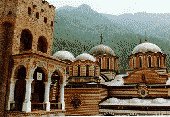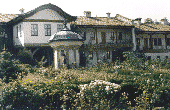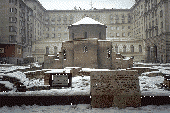|
|
| |
BULGARIA
MONASTERIES AND CHURCHES
When Christian monastic community emerged as a spiritual vanguard of the new Christian world, it was as early as the 4th - 5th century that monasteries began to be built in the Bulgarian lands. Written documents and archaeological excavations from that time testify to the existence of several dozens of monasteries raised on territories that would later be inhabited by Bulgarian people. The construction of the first monasteries followed a Near East scheme that had already established itself in some places in Europe but as early as the 6th century Byzantine plans began gradually to make their influence felt only to turn later into a major standard of constructing Eastern Orthodox monasteries.
The adoption of Christianity as a state religion in 865 gave new scope to monastery building. The excavations in the old Bulgarian capitals of Pliska and Preslav are a convincing proof of the fact that it was in the monastery complexes that the new Christian culture in Bulgaria came into being. From the very beginning the monastic community was called upon to fight for the establishment of a coherent ethnic structure by joining the Proto-Bulgarian and Slav population to common rites and religious traditions thus creating and developing an all-Bulgarian culture.
The bigger monasteries in Bulgaria are: the Rila, Bachkovo, Troyan, Preobrazhenie /Transfiguration/, Kilifarevo, Kapinovo, Cherepish, Rozhen, Ivanovo, Plachkovo, Aladja, Zemen, Dryanovo, Sokoloski, Glozhene, Kremikovtsi, Dragalevtsi, Gorni Voden, Kuklen, Arapovo, Batoshevo, Lopushanski, Maglizh, Etropole, “St. St. Kirik and Iolita”, Shipka monastery with a memorial Church.
 Founded in the 10th century by the Bulgarian monk St. John of Rila, the RILA MONASTERY stood abandoned for a short time in the 15th century when Bulgaria fell to the Ottoman Turks. Later that same century it came to life again and was later restored in the 19th century. Listed as a World Monument of Culture, it houses an interesting museum and offers overnight accommodation.
BACHKOVO MONASTERY
built in 1083 immediately envelops the visitor. From ancient times it was used as an ossuary and both its architecture and wall paintings are exquisite. The winter church of the Archangels has been dated as 12th century, and Tsar Ivan Alexander added new buildings during his reign in the 14th century. Laid waste by the Turks in the 16th century, it was restored in the late 16th century. There is lot to see and admire here, especially the refectory and the domed kitchen, the church of the Assumption and its murals, and the domed church of St. Nicholas.
Legend has it that the foundation of the present PREOBRAZHENIE MONASTERY dates back to the reign of Tsar Ivan Alexander. There are remains still to be seen south of its present site. Falling victim to the excesses of the Ottoman Empire, it stood abandoned until 1825 when hieromonk Zossim from the Rila monastery began restoring it. The main church, the residential wings and the church of the Assumption were all finished within 30 years of the start of the works.
Little is known about the TROYAN MONASTERY before the 15th century, but it certainly must have had a colourful history. It was in the 19th century that the monastic brotherhood restored the monastery, building a beautiful church, spacious residential wings and a tower with belfry.
The DRYANOVO MONASTERY OF ST ARCHANGEL MICHAEL was founded in the 12th century, but was destroyed and rebuilt several times during the Ottoman Empire. The monastery has stood for 150 years on its present site. It contains an ossuary in memory of the fallen insurgents. The monastery also has an interesting historical and geological muse-um, including Neolithic remains found in a nearby cave.
 SOKOLOVO MONASTERY is in Bulgarian terms the younger brother, since it was first founded in 1832, thanks to donations from nearby villages of Etura and Nova Mahala. The guestroom has an impressive gateway dating back to 1836. Although the eastern wing was burnt down, it was later restored in 1981.
STS KYRIK AND YULITA MONASTERY is said to be dated pre-14th century, although the earliest surviving stonework is the fountain dating back to 1696. Repeatedly set on fire by the Ottoman Turks, it was restored to its present day state after 1835. It boasts wonderful examples of icons and church furniture, and has an impressive collection of silver and copper ware.
East-Orthodox churches have a historic significance for the development of the Bulgarian spirituality and for preserving the Bulgarian national identity. Temples to other religions – Catholic, Protestant, Judaism, and Islam co-exist in close neighbourhood for more than a century.
 The “Alexander Nevski” memorial Church is the biggest on in the Balkan Peninsula. It is downtown Sofia close to the Sofia University and the “St. St. Cyril and Methodius” National Library. It was built in the beginning of 20 c. by the prominent Russian architect Pomerantsev in memoriam to those killed in the Russo-Turkish war of 1878.
The “St. Nedelya” Church is in the city’s ideal centre on the “St. Nedelya” square, dividing the main city traffic artery of two streets: the “Vitosha blvd. And the “Knyaginya Maria Louisa” blvd. Built in the period 1856-1863 onto relics from the ancient Roman town of Serdica; destroyed almost completely in a political coup in 1925 and later fully restored.
 The “St. George” Rotunda – this Church is the oldest building in Sofia. It stands behind the “Sheraton”, Sofia hotel amidst the ruins of the ancient town of Serdica. Discovered in it have been two layers of frescos, the oldest dated from the 10 c. AD. At present the Church is a museum, open from Tuesday through Saturday: 10.30 a.m. – 1.00 p.m. and 3.00 – 5.30 p.m.
“St. Sophia” – this is the oldest East-Orthodox Church in Sofia. Built by Byzantine Emperor Justinian in the period 527 – 565 AD, the Church gave the name of the city as early as in the 14 c. During the Ottoman rule it was turned into a mosque. After a devastating earthquake in 19 c. it was abandoned and only in 1900 it was restored in full.
|
|
|
Festivals and Fairs
The Great Koprivshtitza Folklore Festival
The Great Koprivshtitza Folklore Festival is Bulgaria's largest gathering of traditional musicians and singers and is a cross between a pop festival and a medieval fair. It is a sight that knows no equal: thousands of musicians and singers making the hillside above the picturesque village of Koprivshtitza their home for a few days. Coupled with this you have the colourful stalls of the traders and the thousands of visitors who come for the festival.
This is Bulgarian music as it was always played, played by the ancestors of those who first played it. But perhaps it is what happens on the periphery that is the most authentic. Strolling players or soloists, simply playing for the sheer enjoyment. forming new bonds with other musicians or just letting their music ring out over the hillside.
The Bourgas International Folk Festival
The Bourgas International Folk Festival, held annually, attracts a host of Bulgarian and international artists and is held in the second half of August.
The Kazanluk Festival
The Kazanluk Festival of the Roses is held annually in early June, and has grown from a local to an international event. Not only are the roses, Kazanluk's main industry, in full flower. but the town itself blossoms while visitors enjoy the "Rose Picnic" and all the fun of a folklore festival, with its costumes, songs and dance. Should you still have the energy left, you can always visit the old factories where the rose oil is extracted.
St. Trifon's Day
In the agricultural calendar, St. Trifon's Day celebrates the pruning of the vines, and is held on February 14.
Kukerov Den
On the first Sunday before Lent, Kukerov Den celebrates the start of the agricultural year, and all over Bulgaria you can witness processions led by the dancing. leaping Kukeri dressed in colourful masks and costumes.
Baba Marta
Baba Marta is celebrated on March 1 when peasant house-holds brush out the winter cobwebs with a traditional spring clean. and people offer each other tokens of good luck called martenitsas.
Kukeri
Like western countries. the Bulgarian calendar is dotted with important feast days and festivals. The festival of the Kukeri re-enacts ancient surovaki rites to ward off evil spirits and Kukeri fertility rites. Although only held once every five years, it brings together dancers from all over Bulgaria in a rainbow of colours and styles.
St. Lazarus Day
Lazaruvane is also celebrated in spring on St. Lazarus Day, and here village girls considered fit for marriage perform ritual songs and dances.
St. Konstantin and St. Elena Day
The coming of summer is traditionally celebrated on St. Konstantin and St. Elena Day on May 21, and in some of the remoter villages in the Stranzha hills fire dancing, dancing on heated coals, is still practised in celebration of summer's arrival. Ethnologists have suggested that this practice is directly descended from Dionysina rites of the ancient Thracian.
|